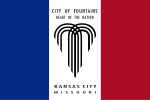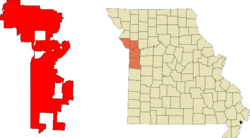Kansas City Police Department
The Kansas City Police Department (KCPD) is the principal law enforcement agency serving Kansas City, Missouri. Missouri Supreme Court Justice Brent Powell swore in Richard C. Smith as the 45th Chief of Police of the Kansas City Missouri Police Department on August 15, 2017.[2] Col. Smith, who served as head of the KCPD's Central Patrol Division,[3] became the city's 45th police chief on August 15, 2017.[4]
| Kansas City Police Department (Missouri) | |
|---|---|
 Patch of the Kansas City Police Department | |
 Flag of Kansas City, Missouri | |
| Common name | Kansas City Police Department |
| Abbreviation | KCPD |
| Motto | To Serve and Protect |
| Agency overview | |
| Formed |
|
| Preceding agency |
|
| Employees | 1,819 (2020) |
| Annual budget | $273 million (2021)[1] |
| Jurisdictional structure | |
| Operations jurisdiction | Kansas City, Missouri, Missouri, US |
 | |
| Map of Kansas City Police Department (Missouri)'s jurisdiction. | |
| Legal jurisdiction | City of Kansas City, Missouri |
| Governing body | [[Governor of Missouri (Mike Parson)]] |
| General nature | |
| Operational structure | |
| Headquarters | 1125 Locust Street, Kansas City, Missouri 64106 |
| Police Officers | 1,299 (2020) |
| Corrections and Civilians | 520 (2020) |
| Police Commissioners responsible |
|
| Agency executives |
|
| Stations | 6
|
| Facilities | |
| Detention Centers | 1 |
| Website | |
| Kansas City Police Department official website | |
Overview
The Mission of the Kansas City Missouri Police Department is to protect and serve with professionalism, honor and integrity.[5]
Kansas City Police Department is the largest city police agency in Missouri, based on number of employees, city population, and geographic area served.
Board of Commissioners
The Kansas City Board of Police Commissioners is responsible for the operation of the KCPD. The Board sets policy, makes promotions, holds both closed and open meetings and coordinates with the Chief of Police in providing police services to the citizens. Four of the five members of the board are selected by the governor of the state of Missouri, following approval of the Missouri legislature, with the mayor serving as the fifth member. Commissioners serve four year terms, however they serve at the pleasure of the governor and can be replaced.
Currently, those Commissioners[6] are:
Current membership
| Member | Term began | Term ends |
|---|---|---|
| Mayor Quinton Lucas | August 1, 2019 | End of mayoral term |
| Nathan Garrett | June 6, 2017 | March 7, 2021 |
| Don Wagner | November 2, 2017 | March 7, 2021 |
| Mark C. Tolbert | June 6, 2017 | March 7, 2022 |
| Cathy Dean | Dec 3, 2019 | Jan 6, 2021 |
Commissioned/sworn positions
The structure of the Senior Command staff of The Police is:
| Title | Insignia |
|---|---|
| Chief of Police | |
| Deputy Chief | |
| Major | |
| Captain | |
| Sergeant | |
| Police Officer | |
| Probationary Police Officer |
Sidearms
The main sidearm used by the KCMO PD is the Glock 22 or Glock 23 both in .40 S&W. Officers also had the choice of choosing the Smith & Wesson Sigma but that is no longer chosen by officers as was the S&W 4026 (Smith & Wesson Model 4006) .40 S&W which had the KCMO PD Badge and KCPD engraved on the slide.[7]
History
The Kansas City Police Department was founded in 1874. George Caleb Bingham was the first president of the Board of Police Commissioners. The first Chief was Thomas M. Speers.
The Kansas City preventive patrol experiment was a landmark experiment carried out between 1972 and 1973 by the Kansas City Police Department. It was evaluated by the Police Foundation. It was designed to test the assumption that the presence (or potential presence) of police officers in marked cars reduced the likelihood of a crime being committed. It was the first study to demonstrate that research into the effectiveness of different policing styles could be carried out responsibly and safely.
Media
The Tactical Response Teams of KCPD was featured in A&E's reality series Kansas City SWAT.[8]
The Kansas City, Missouri Police Department has been portrayed in numerous episodes of the television show COPS.
The Homicide Unit of the Kansas City, Missouri Police Department was portrayed in the A&E Network's documentary series entitled The First 48.
A viral video circulated on Twitter showing KCPD officers assaulting nonviolent protesters, bringing national attention to the department.[9]
Controversies
During the 2020 George Floyd protests, KCPD fired chemical agents, such as pepper spray, at protesters.[10] In wake of these crowd control measures, civil rights groups have called for the resignation of Police Chief Rick Smith, who defended the officers' actions. [11][12]
References
- Sullivan, Carl; Baranauckas, Carla (June 26, 2020). "Here's how much money goes to police departments in largest cities across the U.S." USA Today. Archived from the original on July 14, 2020.
- "KCMO.gov". Kcmo.org. Retrieved 2016-07-20.
- "KC's new police chief is Major Rick Smith". July 28, 2017.
- "Vowing to work to reduce crime, Rick Smith is sworn in as Kansas City's police chief". kansascity.
- "KCPD Mission Statement". KCMO.gov. Retrieved 2016-07-20.
- "BOARD OF POLICE COMMISSIONERS". kcpd.org. Retrieved 2016-07-20.
- https://i.redd.it/l9x1he7w64wy.jpg
- "Kansas City SWAT | TV Guide". TVGuide.com.
- Waldrop, Theresa (3 June 2020). "Video shows police pepper-spraying a protester. All he seemed to be doing was yelling". CNN. Retrieved 3 June 2020.
- Cummings, Ian (1 June 2020). "Photo shows Kansas City police officer pepper spray man in face". The Kansas City Star. Retrieved 3 June 2020.
- Rice, Glenn E. (3 June 2020). "Civil rights groups say Kansas City police chief should resign". The Kansas City Star. Retrieved 3 June 2020.
- Rice, Glenn E. and Kevin Hardy (3 June 2020). "Jackson County prosecutor is reviewing KCPD officers' use of pepper spray on protester". The Kansas City Star. Retrieved 3 June 2020.